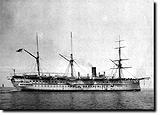| Armed Forces | | In many ways it is surprising that the British armed forces were so small considering how much of the world they would have to cover in order to acquire, police and defend its Empire. Discipline, professionalism and the bravery of her personnel usually (but not always) allowed Britain to punch above its military weight. When it came to fighting indigenous peoples, technology would invariably prove to be the decisive element. It was a different matter when it came to fighting their fellow Europeans - although leadership and bravado seemed to offer surprisingly consistent advantages. But in the case of major, prolonged wars against European rivals, systematic advantages such as industrial and financial muscle would generally allow Britain to stay the course and deal with multiple adversaries. Over time, the Empire itself would become a source of strength as more personnel and resources would come on stream from the colonies as they developed and matured economically. By the time of the First World War, the Empire would supply a major proportion of the fighting capability of the British forces. | | Royal Navy | | Being an island nation, the Royal Navy was (and still is) the Senior Service for a very real reason. Control of the seas would be crucial in defending Britain and in allowing Britain to secure such a vast Empire. Domination of the seas was not definitively achieved until the Battle of Trafalgar in 1805, although Britain had been challenging for supremacy since the Seven Years War. During the Nineteenth Century, the Royal Navy was supreme and could deliver soldiers or marines pretty much anywhere on the planet and also deny rivals the ability to do so themselves. The floating gun vessels could be equally intimidating to indigenous leaders who might have contemplated resisting British encroachment or denying access to commercial opportunities. The Royal Navy would ensure the flow of trade vessels and goods to supply Britain's factories or deliver her products overseas. The Laissez Faire economic model that would enrich Britain could not have existed without the power of the Royal Navy. They controlled the communications and supply lines that made the Empire viable in any meaningful way. | | Army | | By European standards, the British Army was a tiny army. But what it lacked in numbers it made up for in professionalism and confidence. There was an odd combination of a public school educated officer corps bred to lead and a pool of hardy labourers forced off their land and/or workers attempting to avoid the harsh conditions of the new industrial cities. It is interesting that the Scots and Irish supplied such a high proportion of the British armed forces. This was probably due to the lack of economic opportunities in their respective home countries. Whatever the reason, they served the British army extremely ably. It should be remembered that the army was never given the title 'Royal' unlike the other two services. This was due to its perceived unreliability by the monarch - with very good reason to assume so. It dates back to the time of the English Civil War and the defeat of King Charles by the 'New Model Army' of Oliver Cromwell. Subsequent British monarchs never forgot this and so have never bestowed the 'Royal' sobriquet. This is despite the fact that it was the army that allowed the Restoration of the Monarchy in 1660. The element of trust (or lack of it) was also why so many members of the Royal Family were made in to the Colonels in Chief of so many regiments. It was a way of ensuring loyalty. It should be noted that the army has always been a constitutionally interesting organisation. Ever since the Seventeenth Century troubles, Britain has never really appreciated having a large standing army on its soil. Most of the barracks were either overseas in the colonies or closer to home in Ireland - but not so often in England itself. Another hangover of the Seventeenth Century problems is still evident in the constitutional division of responsibilites of the army even to today. All soldiers must pledge allegiance to the monarch, who is the Commander in Chief and yet the purse strings for pay and equipment are firmly in the hands of parliament. It was hoped that this constitutional arrangement would keep the army out of political squabbles and prevent future coups - which it has done remarkably successfully for over 300 years. | | Royal Air Force | | The Royal Air Force grew out of the Royal Flying Corps of World War One. It was formed in 1918 and so is very much the 'baby' of the military establishment. However, the projection of power provided by its weapons allowed it to grow rapidly from the 1920s onwards. Initially hopes were high that air power would be a 'cheap' military option that would tie the empire together and police its wide, open spaces. Operations in Somalia, Afghanistan and Iraq would, however, show its limitations. It was one thing flying the flag by buzzing the locals on the ground - but once the plane had disappeared, power and influence often went with it. Soldiers or police on the ground would prove far more durable in sustaining a presence over a period of time. Air power would complement but not replace land and sea forces. | | Imperial War Graves and Cemeteries | | Over the years, countless thousands have died fighting for or on behalf of Britain and its empire. The way that the soldiers were treated have changed dramatically over the years - for the living, for the wounded but also for the dead. I have added a section which details this changing relationship between the British Empire and those who have died on active service. |
| | |















